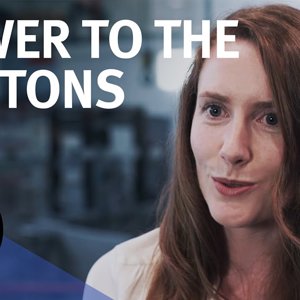You are using an out of date browser. It may not display this or other websites correctly.
You should upgrade or use an alternative browser.
You should upgrade or use an alternative browser.
What is Particle accelerator: Definition and 208 Discussions
A particle accelerator is a machine that uses electromagnetic fields to propel charged particles to very high speeds and energies, and to contain them in well-defined beams.Large accelerators are used for basic research in particle physics. The largest accelerator currently operating is the Large Hadron Collider (LHC) near Geneva, Switzerland, operated by the CERN. It is a collider accelerator, which can accelerate two beams of protons to an energy of 6.5 TeV and cause them to collide head-on, creating center-of-mass energies of 13 TeV. Other powerful accelerators are, RHIC at Brookhaven National Laboratory in New York and, formerly, the Tevatron at Fermilab, Batavia, Illinois. Accelerators are also used as synchrotron light sources for the study of condensed matter physics. Smaller particle accelerators are used in a wide variety of applications, including particle therapy for oncological purposes, radioisotope production for medical diagnostics, ion implanters for manufacture of semiconductors, and accelerator mass spectrometers for measurements of rare isotopes such as radiocarbon. There are currently more than 30,000 accelerators in operation around the world.There are two basic classes of accelerators: electrostatic and electrodynamic (or electromagnetic) accelerators. Electrostatic accelerators use static electric fields to accelerate particles. The most common types are the Cockcroft–Walton generator and the Van de Graaff generator. A small-scale example of this class is the cathode ray tube in an ordinary old television set. The achievable kinetic energy for particles in these devices is determined by the accelerating voltage, which is limited by electrical breakdown. Electrodynamic or electromagnetic accelerators, on the other hand, use changing electromagnetic fields (either magnetic induction or oscillating radio frequency fields) to accelerate particles. Since in these types the particles can pass through the same accelerating field multiple times, the output energy is not limited by the strength of the accelerating field. This class, which was first developed in the 1920s, is the basis for most modern large-scale accelerators.
Rolf Widerøe, Gustav Ising, Leó Szilárd, Max Steenbeck, and Ernest Lawrence are considered pioneers of this field, conceiving and building the first operational linear particle accelerator, the betatron, and the cyclotron.
Because the target of the particle beams of early accelerators was usually the atoms of a piece of matter, with the goal being to create collisions with their nuclei in order to investigate nuclear structure, accelerators were commonly referred to as atom smashers in the 20th century. The term persists despite the fact that many modern accelerators create collisions between two subatomic particles, rather than a particle and an atomic nucleus.
View More On Wikipedia.org
Rolf Widerøe, Gustav Ising, Leó Szilárd, Max Steenbeck, and Ernest Lawrence are considered pioneers of this field, conceiving and building the first operational linear particle accelerator, the betatron, and the cyclotron.
Because the target of the particle beams of early accelerators was usually the atoms of a piece of matter, with the goal being to create collisions with their nuclei in order to investigate nuclear structure, accelerators were commonly referred to as atom smashers in the 20th century. The term persists despite the fact that many modern accelerators create collisions between two subatomic particles, rather than a particle and an atomic nucleus.
View More On Wikipedia.org
-
A
Electrical DIY Particle Accelerator (with magnetic ball)
Hi, currently I am working on a particle accelerator. In the project, basically, by the magnetic force generated by the coil, the magnetic ball is accelerated in a circular path. I first thought that giving current all the time to the coil wouldn't cause problems. However, as it turned out if...- acun
- Thread
- Replies: 7
- Forum: DIY Projects
-
M
A Particle distribution in the longitudinal beam dynamics in accelerator
In longitudinal beam dynamics, particles exhibits a synchrotron motion. The motion has an amplitude (action) dependant synchrotron frequency. The motion is defined in terms of rf phase devotion deviation ##\phi## as: ##H=\dot \phi^2/2 - \Omega_s^2 \cos(\phi)## I am trying to write the particle...- M.A.M.Abed
- Thread
- Replies: 2
- Forum: High Energy, Nuclear, Particle Physics
-

(Help) Surface charge density (σ) for particle to hit plate...
I don't know if i'm exactly right. But I started with x(time) = V cos θ t which = (6810 m/s) cos (69.1°) (11.4 * 10^-3 s) is ... 27.69 m & since Electric field due to uniformly charge surface is represented by... E = (q * σ)/(2 * ε_0 * m), and since acceleration (a) can be expressed as F/m...- chrisbroward
- Thread
- Replies: 4
- Forum: Introductory Physics Homework Help
-
J
What are the limitations of CRT display technology? resolution, nits, ....
I've been reading about how color crt displays work because I've become interested in trying to make one, even if it isn't going to be very good compared to the ones of the past. (yes I know they have high voltage that can arc through material/ air and that voltage drop and electron collisions...- jman5000
- Thread
- Replies: 62
- Forum: Electrical Engineering
-
F
I Having problems finding an equation for radioisotope production yield
I am trying to get a plot, or a result for target like this: I've found some equations for my requested results, but they are from the same person's articles and I couldn't find another source. I've searched for EOB and TTY calculations but couldn't really do something. Could you give me an...- fissile_uranium
- Thread
- Replies: 5
- Forum: High Energy, Nuclear, Particle Physics
-
J
I Removing a proton with a particle accelerator
What would it look like if I used a particle accelerator to remove a proton from a particular element? What would the physical change in the element look like if observed? Would the element appear to "magically" change into something else right before your very eyes, as if by some kind of spooky...- jgav9876
- Thread
- Replies: 10
- Forum: Classical Physics
-

I Acceleration in an electron field
I read something about accelerators using nanotubes. I am a little concerned about the design mentioned in the "High Density with Perpendicular Carbon Nanotubes" part of this paper(https://doi.org/10.3390/photonics8060216). Can wakefield acceleration be done in an electron field? Or maybe I...- redirmigician
- Thread
- Replies: 0
- Forum: High Energy, Nuclear, Particle Physics
-
M
I Are there currently working colliders with unequal beam sizes?
I know that for any coliders beams are not exactly the same size but they can be approximated to the same value as the deviation is relatively small, such as LHC. My questions: 1- are there currently working or planned colliders with unequal beam sizes? 2- for coliders of different particles...- Mikheal
- Thread
- Replies: 9
- Forum: High Energy, Nuclear, Particle Physics
-
T
I Exploring the Universe with a Particle Accelerator
If experiments were conducted with a particle accelerator in a distant space from Earth or even our galaxy somewhere in the universe would the results change? I.e finding different elements ect..- Tayler
- Thread
- Replies: 6
- Forum: High Energy, Nuclear, Particle Physics
-
R
Particle Accelerator concentration
Summary:: What concentration for electrical engineering works on particle accelerators? What concentration for electrical engineering works on particle accelerators?- random123
- Thread
- Replies: 9
- Forum: STEM Career Guidance
-
I
Construction How Can I Build a Homemade Particle Accelerator?
I have very little knowledge on engineering or electrical engineering at the moment, which is why I would like to learn more about it. I have read many articles on them but I am still unclear of some of the materials required for something like this. I am very unqualified to be discussing...- Interested user
- Thread
- Replies: 2
- Forum: DIY Projects
-
F
I Heaviest particle detected so far
I'm reading this article on Dark Matter and at some point the authors say '' if the LKP [Lightest Kalusa-Klein Particle] is to account for the observed quantity of dark matter, its mass [...] should lie in the range of 400 to 1200 GeV, well above any current experimental constraint.'' My...- Floyd_13
- Thread
- Replies: 4
- Forum: High Energy, Nuclear, Particle Physics
-
R
B Isodose contours of HERMES III
These pictures below show four isodose contours of HERMES III with different anode-cathode gaps. The radiation produced are gamma rays. More informations can be seen here in the article https://www.osti.gov/biblio/6233581-hermes-iii-gamma-ray-facility-simulation-technology-laboratory-guide-users...- Rev. Cheeseman
- Thread
- Replies: 1
- Forum: Other Physics Topics
-

A W+/W- bosons ratio in proton-proton collision
Hi guys, I'm studying my first-year physics in college, and I'm having to write a report of some proton-proton collisions that were registered in the LHC of CERN years ago. The main goal is to identify different bosons (W and Z) that are decaying into other elemental particles. I've been asked...- Vicga
- Thread
- Replies: 5
- Forum: High Energy, Nuclear, Particle Physics
-
L
Energy, current and electrical potential of a particle accelerator 🎆
Hello, I have answered the question below but would like some advice on whether I can improve my answer or if anyone is able to check whether I have made any mistakes ? i. 1 V = 1eV in a 1:1 relationship, therefore; 6.5 TeV = 6.5 TV = 6.5 *10^12V ii. E=W W=V * Q Q=number of particles * charge...- lpettigrew
- Thread
- Replies: 34
- Forum: Introductory Physics Homework Help
-
L
I Particle Accelerator with the Earth's diameter
If particle accelerators with circumference of the Earth could be built (imagine around the world). How many TeV can it reach? Maybe new physics can occur at 2000 TeV. I heard the US nuclear arsenals costs 2 trillion dollars. Worldwide, the total costs of all nations nuclear arsenals may reach...- lucas_
- Thread
- Replies: 4
- Forum: High Energy, Nuclear, Particle Physics
-
F
Proton Structure: De Broglie Wavelength & Resolution
Hi all. I'd personally consider the De Broglie wavelength λ=h/p, with p being the momentum of the electron beam. I get $$\lambda \simeq 0.6 \times 10^{-18} m $$ and since the radius of a quark is ## \leq 10^{-19} m ##, the proton structure can't be resolved. I'm quite sure there's something...- Federica
- Thread
- Replies: 5
- Forum: Advanced Physics Homework Help
-
E
I Advancements in Cyclotron Particle Accelerator Design: A Scientist's Perspective
I've been working on modifying the cyclotron particle accelerator. Tell me what you think? It's pretty basic though- Edzim
- Thread
- Replies: 2
- Forum: High Energy, Nuclear, Particle Physics
-
A
I want to build a particle accelerator
Yes it sounds like I've lost it but I really want to build one. I was wondering is someone could guide me to useful resources. I'm currently reading some patents I found online to gain some more insight. Any help would be appreciated. Thank you. -
A
A Influence on Neutron spectrum due to energy loss of beam
Suppose some protons are impacted on a Lithium target to produce neutrons with energies close to the proton energy. If one considers Energy-loss due to proton-target collision (ionization of the target atoms), will this kind of energy loss influence neutron energy spectrum? I am asked by my...- andy95220
- Thread
- Replies: 8
- Forum: High Energy, Nuclear, Particle Physics
-
J
I Can Cosmic Rays Be Economically Used in Particle Accelerators?
would it be a more economical idea to accelerate cosmic rays from the atmosphere which are already traveling at 43 percent of speed of light as particles in a particle accelerator. Do you think that this would be more economical in principle or that you could achieve higher collision speeds?- john taylor
- Thread
- Replies: 5
- Forum: High Energy, Nuclear, Particle Physics
-

A Ion Generation Troubleshooting: Overcoming Limitations in Small Ion Accelerators
I have to increase ion generation in a small ion accelerator but I have troubles to go over 20mA (1.27e17 ions/second). I can modulate up to 40 Mhz at 1kV. What ion generator it is recommended gor large ion flux?, I can work in pulse generation.- Javier Lopez
- Thread
- Replies: 10
- Forum: High Energy, Nuclear, Particle Physics
-
I
Solving a Disappearing Voltage Puzzle: The Ball Cyclotron Project
Homework Statement I'm making a ball cyclotron (https://rimstar.org/science_electronics_projects/ball_cyclotron_electrostatic_accelerator.htm) for a school project. To generate enough voltage, I'm using a Van der Graaf-generator. The problem is that all the voltage, which I can measure...- irdeg
- Thread
- Replies: 1
- Forum: Introductory Physics Homework Help
-

B Creation and annihilation operators in particle physics
I was recently reading about annihilation and creation operators in particle physics using the model of an harmonic oscillator, and then quantizing it. This is fine. I can understand it. But how does this quantization of the energy of the harmonic oscillator manifest physically? Is it that only...- Sophrosyne
- Thread
- Replies: 6
- Forum: Quantum Physics
-
J
CNO fusion using particle accelerator?
The CNO cycle (see https://en.wikipedia.org/wiki/CNO_cycle) is a catalytic fusion reaction that produces energy in stars larger than the sun. It converts four protons into a helium-4 nucleus using a cycle of carbon, nitrogen and oxygen isotopes as catalysts and releases 26.7 MeV of energy mostly...- jcap
- Thread
- Replies: 3
- Forum: Nuclear Engineering
-

I Closing the Gap: The Evolution of CMS at CERN
In this picture of CMS, there is a huge gap between the two sides. There is no way that the collision occur directly in midair right? So is the gap already been sealed? ( which means the picture was taken before it started to operate) Or I am completely wrong?- YoungPhysicist
- Thread
-
- Tags
- Cern Cms Gap Lhc Particle accelerator
- Replies: 5
- Forum: High Energy, Nuclear, Particle Physics
-
N
I Length Contraction of Protons in the LHC
What affect does the phenomenon of "length contraction" have on the shape (e.g. spherical, rugby ball, barbell, donut) of protons accelerated to 0.999999991 c in the LHC?- Neil Marshall
- Thread
- Replies: 18
- Forum: High Energy, Nuclear, Particle Physics
-
A
Electron speed and acceleration in an electric field
Hi everyone, I often work on a SEM, a type of microscope which is based on electron acceleration between an electron source and the sample you are working on. For this reason and since a few weeks I was wondering how an electron (in term of speed) behaves in a constant and linear electric field...- Antoine DEBRAY
- Thread
- Replies: 9
- Forum: Electromagnetism
-
H
Find the minimum distance between 2 particles
Homework Statement A point particle of mass m and charge q(>0) approaches to a point particle Q(>0) at a fixed position. When the distance between the two particles is L, the speed of the moving particle is v. The permittivity of the vacuum is denoted as Epsilon0. Find the minimum distance...- Helly123
- Thread
- Replies: 4
- Forum: Introductory Physics Homework Help
-

What is the Future of Particle Accelerators? with Suzie Sheehy
Suzie Sheehy is particle physicist with a knack for science presenting. She currently holds a joint appointment with STFC and ASTeC to work at Oxford University on high power hadron accelerators.- Wrichik Basu
- Media item
- particle accelerator
- Comments: 0
- Category: Particle
-

How to Design a Particle Accelerator - with Suzie Sheehy
Suzie Sheehy is particle physicist with a knack for science presenting. She currently holds a joint appointment with STFC and ASTeC to work at Oxford University on high power hadron accelerators.- Wrichik Basu
- Media item
- particle accelerator
- Comments: 0
- Category: Particle
-

What is the Future of Particle Accelerators? with Suzie Sheehy (Questions and Answers)
Suzie Sheehy is particle physicist with a knack for science presenting. She currently holds a joint appointment with STFC and ASTeC to work at Oxford University on high power hadron accelerators.- Wrichik Basu
- Media item
- particle accelerator
- Comments: 0
- Category: Particle
-

Particle Accelerators Reimagined - with Suzie Sheehy
Suzie Sheehy is particle physicist with a knack for science presenting. She currently holds a joint appointment with STFC and ASTeC to work at Oxford University on high power hadron accelerators.- Wrichik Basu
- Media item
- particle accelerator
- Comments: 0
- Category: Particle
-

Powering a Particle Accelerator
How do you power a particle accelerator firing beams of protons 50 times a second into a heavy metal target? The ISIS neutron and muon source provides a near constant stream of particles for a huge range of research uses. Take a look at what it takes to keep a decades-old particle accelerator runnin- Wrichik Basu
- Media item
- particle accelerator
- Comments: 0
- Category: Particle
-

Beyond the Higgs: What's Next for the LHC? - with Harry Cliff
Harry Cliff is the Science Museum Fellow of Modern Science, which he reckons might be the only job title which begins and ends with 'science'. He spends half his time searching for signs of new physics at LHCb, one of the four big experiments at CERN's Large Hadron Collider.- Wrichik Basu
- Media item
- cern higgs boson particle accelerator
- Comments: 0
- Category: Particle
-

Beyond the Higgs: What's Next for the LHC? - with Harry Cliff (Question and Answers)
- Wrichik Basu
- Media item
- cern higgs boson particle accelerator
- Comments: 1
- Category: Particle
-

What would be the capacitance of a particle on a plate?
Homework Statement There is a charged particle at height h over a circular area of radii R, then I have to calculate the capacitance. This is useful when somebody want to calculate energy harvesting, antennas, sensors that measures ions in plasma devices and particle accelerators...- Javier Lopez
- Thread
- Replies: 12
- Forum: Advanced Physics Homework Help
-
M
Engineering What can a nuclear engineer do in a particle accelerator ?
Do they need a nuclear engineer in a Synchrotron ? if yes what kind of job does he do ?- madhisoka
- Thread
- Replies: 2
- Forum: STEM Career Guidance
-
A
Quick Question on Van de Graaff Particle Accelerators
Hi everyone. Just a small, quick question I have: Can negative ions be accelerated by a Van de Graaff particle accelerator? My initial reaction is no, because the terminal (the sphere with the charges allocated on the outside) is positive, which means negative ions would be attracted and not...- Abu
- Thread
- Replies: 1
- Forum: Mechanics
-
A
Understanding the Cockcroft Walton Generator: How Does it Work?
Hi everyone. I am doing some research about Cockcroft Walton Accelerators, because I need to be able to explain them to others as a part of a project. However, in order to understand the Cockcroft Walton Accelerator, I need to be able to understand the Cockcroft Walton Generator first. I have...- Abu
- Thread
- Replies: 11
- Forum: Mechanics
-

I How does one find interaction radius for Coulomb barrier?
For a proton striking an atomic nucleus (in a Cockcroft-Walton accelerator, for example), the Coulomb barrier must be overcome. The calculation of the Coulomb barrier is U = k Z1Z2 e2 / r r is interaction radius. How can I find that? For a proton to enter the atomic nucleus what would it be?- eigenmax
- Thread
- Replies: 2
- Forum: High Energy, Nuclear, Particle Physics
-

I want to make a small particle accelerator for cheap.
I am looking for a way to make a small particle accelerator for really cheap. I am in 8th grade and do not know a lot or have a lot of money but still want a project. if you have a pdf or other doc of plans that would be much appreciated thanks. -
S
Iron Man - Palladium Reactor Theory
I'm curious about something. And most of you are probably going to click away as soon as I say, or type this, I guess. But for those of who haven't, thanks. In the Iron Man comics, movies and tv shows the arc reactor keeps Tony Stark from lethal heart damage and keeps the Iron Man Armour...- Scruffy
- Thread
- Replies: 3
- Forum: Science Fiction and Fantasy Media
-

B Measuring momentum and position in particle colliders
When we look at those pictures of colliding particles in particle colliders, we see a large collection of curves and lines radiating out from the point of collision, representing the new particles which have been created. So two questions about this: 1) Why are these acting like particles in...- Sophrosyne
- Thread
- Replies: 12
- Forum: Quantum Physics
-

B Question about time and particle interactions
First, I am new to physics and only taking my first course in calculus based classical mechanics with topics covering thermodynamics and an introduction to general and special relativity. Everything here is pretty much a question, even if periods exist and not question marks. My teacher had...- MrDickinson
- Thread
- Replies: 30
- Forum: Special and General Relativity
-

I Particle accelerator question -- when the protons "crash" particles are created
I'm not sure if this is the right place for this question., but I'll ask anyways. So in particle accelerators when the protons "crash" particles are created because of the extremely high amount of energy(example of e=mc^2?)? Is that correct? Also, where do these particles come from? The Higgs...- deuce123
- Thread
- Replies: 6
- Forum: High Energy, Nuclear, Particle Physics
-

B Is my Cockcroft-Walton accelerator design correct?
I am building a Cockcroft-Walton accelerator for a science fair project, so how does this design sound? Starting from the top, there is a polished steel terminal, like a VDG terminal. Inside here is the proton source and power supply to the source (the source is a hydrogen discharge tube) . The...- eigenmax
- Thread
- Replies: 10
- Forum: High Energy, Nuclear, Particle Physics
-
P
A site that explains the physics behind particle Accelerators?
Please, can you give me a site where the physics of particle accelerators is explaimed with numbers and equations to high school Level? I found the site of the department of Energy and the cern but there are not equations like the lorentz force and the oscillating fields... I need something a...- physics user1
- Thread
- Replies: 1
- Forum: Mechanics
-

News Ancient particle accelerator discovered on Mars
"The search for water, or even signs of life, on the planet Mars has been ongoing for some time. But with today’s announcement by CERN and NASA scientists, the exploration of the red planet has revealed a major new discovery. New images of the surface of Mars taken by NASA’s Mars Reconnaissance...- EnumaElish
- Thread
- Replies: 5
- Forum: General Discussion
-
A
B Measuring the energy of particles
If i have the momentum of the particle, could I measure their energy ? I'm talking about particles in a beam, they are moving in a relativistic speed.- aveline de grandpre
- Thread
- Replies: 4
- Forum: High Energy, Nuclear, Particle Physics